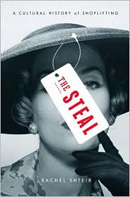The Steal: A Cultural History of Shoplifting

Author: Rachel Shteir
New York, NY: The Penguin Press, 2011.256p.
Reviewer: Brian T. Smith | November 2011
This popular press book is a timely addition to the literature on shoplifting—an often understudied and misunderstood crime. Shteir provides a cultural history of shoplifting spanning several hundred years. This review includes a description of 16th century Elizabethan England ‘lifters,’ revolutionary shoplifters in 1960’s America and present day organized retail crime groups. Following the descriptions of culture and societal views evolving over time, the book focuses on present-day issues.
Shteir interviews criminologists, who add credibility when explaining the causes of shoplifting, methods of theft and retail loss prevention tactics. She presents a useful overview of the popular environmental explanations of shoplifting, including ‘hot products’ and ‘CRAVED.’ Other topics covered include kleptomania and celebrity shoplifting cases. These references are enjoyable, albeit less useful for criminologists.
Shteir devotes a portion of the book to women and shoplifting. Citing empirical studies and official government statistics, she explains that shoplifting is a crime committed at similar rates by men and women. While criminologists and feminist researchers may already be aware of this, it serves as an important theme for the book’s intended audience. Shteir’s contemporary feminist insights make this section an interesting read.
She makes clear that many members of the public are unaware of how retailers protect their merchandise and apprehend shoplifters. In the introduction, Shteir provides an engaging description of a shoplifting committed by Winona Ryder which results in an apprehension by store staff. In the ‘remedies section,’ she exposes the secrets of retail loss prevention. She shows how technology has contributed to the improvement of anti-shoplifting and ‘benefit denial’ devices such as electronic tags, surveillance cameras and merchandise motion detectors.
Shteir illuminates the laws that apply to shoplifting and discusses the many potential pitfalls concerning apprehension. She describes cases in which innocent people were falsely apprehended for theft by store staff. The section on ‘shopping while black’ indicates that African American shoplifters are punished more harshly than whites. This has led to civil rights lawsuits and policy changes for stores—some of which practiced racial profiling and had established apprehension quotas to evaluate their loss prevention officers.
Retail loss prevention typically focuses on the detection and apprehension of shoplifters. However, as Shteir points out, the current economic climate has led some retailers to seek alternative strategies. She describes deterrence measures stores are now using to prevent shoplifting incidents from occurring. For example, salespeople greeting or asking every customer if they need help—known in retail as ‘aggressive hospitality’—supposedly makes potential shoplifters less likely to offend. She explains how these deterrence strategies can effectively reduce stores’ legal fees and false-arrest judgments.
The book is readable and enjoyable. It successfully combines cultural and historical detail while providing an accurate description of modern shoplifting. While not intended to be primary reading for a university course, it could easily serve as supplementary reading for discussions on retail crime or women and crime.
Brian T. Smith is a Ph.D. student at the School of Criminal Justice, Rutgers University- Newark


